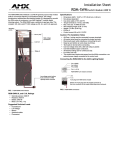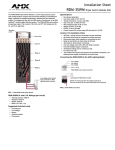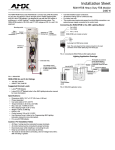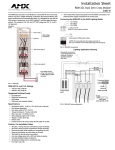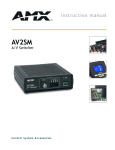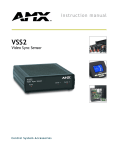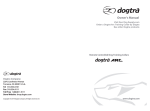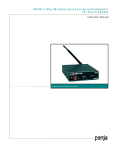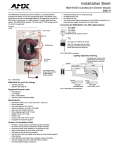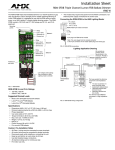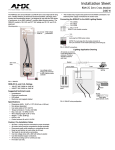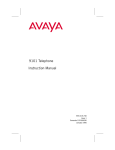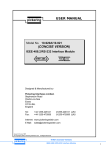Download AMX TX-MLCD User's Manual
Transcript
7;00/&' 0LQL0/&' 7UDQVPLWWHU
,QVWUXFWLRQ 0DQXDO
7UDQVPLWWHUV
Limited Warranty and Disclaimer
AMX Corporation warrants its products to be free from defects in material and
workmanship under normal use for a period of three years from date of purchase
from AMX, with the following exceptions. Electroluminescent and LCD control
panels are warranted for a period of three years, except for the display and touch
overlay components, which are warranted for a period of one year. Disk drive
mechanisms, power supplies, modifications, MX Series products, and KC Series
products are warranted for a period of one year. Unless otherwise specified, OEM
and custom products are covered for a period of one year. AMX software products
are warranted for a period of 90 days. Batteries and incandescent lamps are not
covered.
This warranty extends to products purchased directly from AMX or an authorized
AMX dealer. Consumers should inquire from selling dealer as to the nature and
extent of the dealer’
s warranty, if any.
AMX is not liable for any damages caused by its products or for the failure of its
products to perform, including any lost profits, lost savings, incidental damages, or
consequential damages. AMX is not liable for any claim made by a third party or
made by you for a third party.
This limitation of liability applies whether damages are sought, or a claim is made,
under this warranty or as a tort claim (including negligence and strict product
liability), a contract claim, or any other claim. This limitation of liability cannot be
waived or amended by any person. This limitation of liability will be effective even
if AMX or an authorized representative of AMX has been advised of the possibility
of any such damages. This limitation of liability, however, will not apply to claims
for personal injury.
Some states do not allow a limitation of how long an implied warranty lasts. Some
states do not allow the limitation or exclusion of incidental or consequential
damages for consumer products. In such states, the limitation or exclusion of the
Limited Warranty may not apply to you. This Limited Warranty gives you specific
legal rights. You may also have other rights that may vary from state to state. You
are advised to consult applicable state laws for full determination of your rights.
EXCEPT AS EXPRESSLY SET FORTH IN THIS WARRANTY, AMX MAKES NO OTHER
WARRANTIES, EXPRESSED OR IMPLIED, INCLUDING ANY IMPLIED WARRANTIES OF
MERCHANTABILITY OR FITNESS FOR A PARTICULAR PURPOSE. AMX EXPRESSLY
DISCLAIMS ALL WARRANTIES NOT STATED IN THIS LIMITED WARRANTY. ANY IMPLIED
WARRANTIES THAT MAY BE IMPOSED BY LAW ARE LIMITED TO THE TERMS OF THIS
LIMITED WARRANTY.
Table of Contents
Introduction ............................................................................ 1
Overview
1
Features
1
Operation
2
Wiring the TX-MLCD
3
AXCESS Programming ........................................................... 5
Overview
5
Programming Restrictions
6
Programming Basics
6
Sample Program
8
Specifications....................................................................... 15
Overview
15
Technical Support ................................................................ 17
Overview
TX-MLCD Mini-LCD Transmitter
17
Table of Contents
i
ii
Table of Contents
TX-MLCD Mini-LCD Transmitter
Introduction
Overview
The TX –MLCD (Figure 1) is a programmable Radio Frequency (RF) or
Infrared (IR) wireless transmitter. Text for TX–MLCD menu functions is
presented on a 2-line, 16 character, horizontal liquid crystal display (LCD).
All TX–MLCD functions are under software control. The TX–MLCD is
completely compatible with a subset of the AXCESS System programming
language described in the programming section of this User Guide. Figure 1
is an illustration of the TX–MLCD panel arrangement.
Figure 1
Red LED
Transmit
TX-MLCD panel
Horizontal LCD
Screen and
Source Dots
SOURCE
Six Function
Keys
RS–232 Port
(on side)
IBM
VHS
UMATIC
SLIDES
MAC
CASS
LSR DS
DUAL
AUX
VOLUME
LIGHTS
V-SHOW
Twelve User
Defined Menu
Selection Keys
(Programmable)
Features
TX –MLCD features include:
• Twenty button matrix — configured as needed by the user.
• LCD— displays up two lines of 16 text characters each for the
programmed menu selection key.
• Transmit LED— indicates that an RF or an IR signal is being
transmitted by the TX–MLCD. The choice of RF or IR is selected
initial manufacture of the unit.
TX-MLCD Mini-LCD Transmitter
Introduction
1
• RS–232 port— used to program the TX–MLCD functions. The data
rate is fixed at 1200 baud (bps).
• Portable — the AMX TX–MLCD uses four AAA batteries for
completely portable operation.
Operation
Once a program, like the example in the appendix, is loaded, your TX–
MLCD provides complete menu selection of up to 12 control menus with up
to 6 functions each. Menu selections allow you to control a wide range of
devices with RF or IR signals according to your needs.
• RF or IR selection— The operating mode is determined at the time the
equipment order is placed. RF or IR capability is factory installed in
the unit at the time of assembly.
• Turn the TX–MLCD on— Press any button to activate the menu
screen. The last selected menu will appear first. Press the desired
menu selection button for the menu you want.
• Time out— A power saving feature. If no function key activity occurs
for approximately 2 minutes, the screen will go dark. Press any key to
return to the last selected menu.
• Control Function Menus— Press one of the 12 menu selection keys to
activate a menu of six control functions.
Press one of the 6 circles to activate the corresponding function next to the
dots above and below the display. Figure 2 shows a sample TX-MLCD with
three of the twelve possible function menus.
Figure 2
Sample TX-MLCD menu
options
MI D <- DRPS- > CONF
LOW ( LI GHTS)
AV
SOURCE
PSE <<SRCH>> PLY
REW ( UMATI C) STP
SOURCE
ENT <- CRSR- > FWD
F1 ( MAC ) REV
SOURCE
2
Introduction
TX-MLCD Mini-LCD Transmitter
Wiring the TX-MLCD
Figure 3 shows how to connect the TX–MLCD RS–232 port to an AXCESS
RS–232 cable for programming.
Cable Wiring 9-Pin D to Stereo Plug
Pin 2 to Ring Terminal
Pin 3 to Tip Terminal
Pin 5 to Sleeve Terminal
Figure 3
RS-232 adapter cable wiring
diagram (AXCESS-to-TX-
9-Pin
D Male
MLCD)
2 TXD
3 RXD
5 Ground
TX-MLCD Mini-LCD Transmitter
Length = 8 to 10 inches
Tip
(3)Tip
(2)Ring
(5)Sleeve
2.5mm Stereo Plug
Ring
Sleeve
Introduction
3
4
Introduction
TX-MLCD Mini-LCD Transmitter
AXCESS Programming
Overview
You can use the AXCESS software to program all features of the TX–MLCD.
A working knowledge of the AXCESS programming language is needed
to thoroughly understand the operation of the TX–MLCD. Language
features include screen control, character position control, and
commands for implementing TX–MLCD functions. The following subset
of the AXCESS Language commands are supported for the TX–MLCD:
CALL
CANCEL_ALL_WAIT
CANCEL_WAIT
DEFINE_CONSTANT
DEFINE_DEVICE
DEFINE_PROGRAM
DEFINE_START
DEFINE_VARIABLE
IF...ELSE
ITOA
OFF
ON
PUSH
PUSH_CHANNEL
RELEASE
SEND_STRING
TO
WAIT
all mathematical operators (+, ,
– *, /)
all logical operators (AND, OR, NOT, XOR)
all bitwise operators (BAND, BOR, BNOT, BXOR)
TX-MLCD Mini-LCD Transmitter
AXCESS Programming
5
Programming Restrictions
AXCESS program restrictions include:
1. DEFINE_LATCHING, DEFINE_MUTUALLY_EXCLUSIVE, and
DEFINE_TOGGLING are not supported. Similar functions are
accomplished with combinations of ON, OFF, and IF… ELSE.
2. PULSE is not supported. A similar function is accomplished with
combinations of ON, WAIT, and OFF
3. String support is limited:
• No access to individual array elements
• No string comparisons
• Some string functions are not supported (e.g., LEFT_STRING, and so
on.)
• Maximum string length is 36 characters.
4. Concurrent WAITS— 5 maximum.
5. Concurrent TOs— 5 maximum.
6. Nesting of levels— 3 maximum. With more than three, an internal
stack overflow may occur resulting in erratic, undefined behavior.
7. Total memory size— 4.5Kbytes. SOURCE–SEND will often need to be
turned OFF resulting in the inability to RETRIEVE a program from
the TX–MLCD. There may not be enough memory in the TX–MLCD
to include the program source code and the compiled (executable)
program.
Programming Basics
The following information is helpful when programming the TX–MLCD:
• TX–MLCD is assigned device code number one. To use channel and
SEND_STRING commands for sending text to the LCD screen:
DEFINE_DEVICE
MLCD=1
• Use device code number zero to return characters from the TX–
MLCD RS–232 port. Returning characters from TX–MLCD can be
useful for debugging.
6
AXCESS Programming
TX-MLCD Mini-LCD Transmitter
• A PUSH occurs in the program every time a button (key) is pressed.
Figure 4 shows the button assignments.
Figure 4
Button assignments
Top Left = 1
•
•
•
5
6
•
•
•
10
4
•
•
•
15
16
•
•
•
20 = Bottom Right
• Turning on channels 1 through 254 enables transmission (RF or IR) of
the respective radio code. The code example below transmits radio
code 128 when button 1 is pressed.
PUSH[SK, 1]
TO[SK, 128]
• Use SEND_STRING to send characters to the LCD screen. Characters
will start at the current cursor position.
• Special SEND_STRING escape sequences are included in the TX–
MLCD commands. When included within a SEND_STRING program
instruction, the following character combinations will be treated as
commands:
— "2" moves the cursor to home (line one, column one)
— "9" moves the cursor one position right
— "10" moves the cursor one position down (to next line)
— "12", clears the screen and moves the cursor to home (line one,
column one)
— "13" moves the cursor to first of line (column one)
— "17,<line number>,<column number>"
specified line and column
moves the cursor to the
• When a button is pressed, the TX–MLCD unit powers-up and runs
through the DEFINE_START section. The DEFINE_START section is
the part of the program where the text for each of the screens is setup
and initialized. With the text already initialized, the main part
(DEFINE_PROGRAM) of the program is shorter and simpler
allowing you to flip from one screen to another with a
SEND_STRING command.
TX-MLCD Mini-LCD Transmitter
AXCESS Programming
7
Sample Program
Figure 5 is a sample demo AXCESS software program for a TX-MLCD.
Refer to the AXCESS Language Programming Guide for complete
programming instructions.
Figure 5
Sample AXCESS software
program
PROGRAM_NAME='TXMLCD 6 BUTTON DEMO PROGRAM, RSH 04-29-91'
(*
DATE:04/28/92
TIME:16:53:22
*)
(*
THIS IS A GENERIC PROGRAM THAT CREATES 6 VARIABLE FUNCTION
BUTTONS
BUTTONS DENOTED WITH A * BELOW. THE REMAINING THREE ROWS ARE
USED
FOR MENU SELECTIONS.
BUTTON NUMBERING:
1* 6* 11* 16*
2* 7
12
17*
3
8
13
18
4
9
14
19
5 10
15
20
BUTTONS 7 AND 12 ARE NOT USED IN THIS PROGRAM.
FUNCTION BUTTONS GIVE FEEDBACK 'WINK', A DASHED LINE, THAT
REPLACES
THE FUNCTION TEXT AND THEN RESTORES IT ON RELEASE OF THE BUTTON.
THE 12 MENU SELECTION BUTTONS TRANSMIT RADIO CODES 1-12 AND
OFFSET
THE RADIO CODES THAT THE FUNCTION BUTTONS WILL THEN TRANSMIT.
FOR EXAMPLE, IF MENU SELECTION 1 IS PRESSED THEN FUNCTIONS 1-6 WILL
TRANSMIT RADIO CODES 32-37 AND IF MENU SELECTION 2 IS PRESSED
THEN FUNCTIONS 1-6 WILL TRANSMIT RADIO CODES 40-45 AND SO ON.
*)
(***********************************************************)
(*
DEVICE NUMBER DEFINITIONS GO BELOW
*)
(***********************************************************)
DEFINE_DEVICE
MLCD = 1
(* TX MLCD IS ALWAYS DEVICE 1 *)
(***********************************************************)
(*
CONSTANT DEFINITIONS GO BELOW
*)
(***********************************************************)
DEFINE_CONSTANT
(***********************************************************)
(*
VARIABLE DEFINITIONS GO BELOW
*)
(***********************************************************)
8
AXCESS Programming
TX-MLCD Mini-LCD Transmitter
DEFINE_VARIABLE
BA[4]
(* LCD VARIABLE FORMAT *)
BB[4]
BC[2]
(* BA BC FILL BD BF *)
BD[2]
(* BB ( SOURCE ) BE *)
BE[4]
BF[4]
FILL[4]
SOURCE[6]
BTEMP[4]
(* FOR TEMPORARILY SAVING BA, BB, BC, BD, BE, OR BF *)
RC
(* RADIO CODE OFFSET AFTER MENU SELECTION *)
(***********************************************************)
(*
LATCHING DEFINITIONS GO BELOW
*)
(***********************************************************)
DEFINE_LATCHING
(***********************************************************)
(*
DEFINE CALLS GO BELOW
*)
(***********************************************************)
DEFINE_CALL 'LCD' (* UPDATE LCD SCREEN *)
{
SEND_STRING MLCD,"$0C"
(* CLEAR SCREEN AND MOVE
CURSOR HOME *)
SEND_STRING MLCD,"BA,BC,FILL,BD,BF"
(* WRITE FIRST LINE *)
SEND_STRING MLCD,"$11,2,1"
(* MOVE CURSOR TO LINE 2
COLUMN 1 *)
SEND_STRING MLCD,"BB,'(',SOURCE,')',BE" (* WRITE SECOND LINE *)
}
(***********************************************************)
(*
STARTUP CODE GOES BELOW
*)
***********************************************************
DEFINE_START
(***********************************************************)
(*
THE ACTUAL PROGRAM GOES BELOW
*)
(***********************************************************)
DEFINE_PROGRAM
PUSH[MLCD,3]
{
TO[MLCD,1] (* MENU SELECTION 1 TRANSMITS RC 1, DELETE LINE IF
NOT NEEDED *)
BA='
' BC=' '
FILL='
'
BD=' ' BF=' ON'
BB='
'
SOURCE=' IBM '
BE=' OFF'
CALL'LCD'
RC=32
(* OFFSET FOR RADIO CODES, FUNCTIONS 1-6 WILL
TRANSMIT 32-37 *)
TX-MLCD Mini-LCD Transmitter
AXCESS Programming
9
}
PUSH[MLCD,4]
TO[MLCD,2] (* MENU SELECTION 2 TRANSMITS RC 2 *)
BA='ENT ' BC='<-'
FILL='CRSR'
BD='->' BF=' FWD'
BB='F1 '
SOURCE=' MAC '
BE=' REV'
CALL'LCD'
RC=40
(* FUNCTIONS 1-6 WILL NOW TRANSMIT 40-45 *)
}
PUSH[MLCD,5]
{
TO[MLCD,3]
BA='#1 ' BC='#2'
FILL='
'
BD='#3' BF=' #4'
BB='#5 '
SOURCE=' AUX '
BE=' OFF'
CALL'LCD'
RC=48
}
PUSH[MLCD,8]
{
TO[MLCD,4]
BA='PSE ' BC='<<'
FILL='SRCH'
BD='>>' BF=' PLY'
BB='REW '
SOURCE=' VHS '
BE=' STP'
CALL'LCD'
RC=56
}
PUSH[MLCD,9]
{
TO[MLCD,5]
BA='PSE ' BC='<<'
FILL='
'
BD='>>' BF=' PLY'
BB='REC '
SOURCE=' CASS '
BE=' STP'
CALL'LCD'
RC=64
}
PUSH[MLCD,10]
{
TO[MLCD,6]
BA='ON ' BC='1-'
FILL='PRST'
BD='-2' BF=' UP'
BB='OFF '
SOURCE='VOLUME'
BE=' DWN'
CALL'LCD'
RC=72
}
PUSH[MLCD,13]
{
TO[MLCD,7]
BA='PSE ' BC='<<'
FILL='SRCH'
BD='>>' BF=' PLY'
BB='REW '
SOURCE='UMATIC'
BE=' STP'
CALL'LCD'
RC=80
}
PUSH[MLCD,14]
{
10
AXCESS Programming
TX-MLCD Mini-LCD Transmitter
TO[MLCD,8]
BA='PSE ' BC='<<'
FILL='CHPT'
BD='>>'
BB='HOME'
SOURCE='LSR DS'
CALL'LCD'
RC=88
}
PUSH[MLCD,15]
{
TO[MLCD,9]
BA='MID ' BC='<-'
FILL='DRPS'
BD='->'
BB='LOW '
SOURCE='LIGHTS'
CALL'LCD'
RC=96
}
PUSH[MLCD,18]
{
TO[MLCD,10]
BA='ON ' BC='<-'
FILL='FOCS'
BD='->'
BB='OFF '
SOURCE='SLIDES'
CALL'LCD'
RC=104
}
PUSH[MLCD,19]
{
TO[MLCD,11]
BA='FWD ' BC='R<'
FILL='DUAL'
BD='>F'
BB='REV '
SOURCE=' DUAL '
CALL'LCD'
RC=112
}
PUSH[MLCD,20]
{
TO[MLCD,12]
BA='MENU' BC=' <'
FILL='- -'
BD='> '
BB='CNTU'
SOURCE='V-SHOW'
CALL'LCD'
RC=120
}
(* FEEDBACK WINK ---- FOR FUNCTION KEYS *)
PUSH[MLCD,1] (*BA*)
{
TO[MLCD,RC+1]
BTEMP=BA
(* SAVE THE TEXT TEMPORARILY
BA='--- '
(* REPLACE TEXT WITH --- *)
CALL'LCD'
}
RELEASE[MLCD,1]
{
BA=BTEMP
(* RESTORE THE TEXT *)
CALL'LCD'
TX-MLCD Mini-LCD Transmitter
BF=' PLY'
BE=' STP'
BF='CONF'
BE=' AV'
BF=' FWD'
BE=' REV'
BF=' FWD'
BE=' REV'
BF='
BE='
^ '
v '
*)
AXCESS Programming
11
PUSH[MLCD,2] (*BB*)
{
TO[MLCD,RC]
BTEMP=BB
BB='--- '
CALL'LCD'
}
RELEASE[MLCD,2]
{
BB=BTEMP
CALL'LCD
}
PUSH[MLCD,6] (*BC*)
{
TO[MLCD,RC+2]
BTEMP=BC
BC='--'
CALL'LCD'
}
RELEASE[MLCD,6]
{
BC=BTEMP
CALL'LCD'
}
PUSH[MLCD,11] (*BD*)
{
TO[MLCD,RC+3]
BTEMP=BD
BD='--'
CALL'LCD'
}
RELEASE[MLCD,11]
{
BD=BTEMP
CALL'LCD'
}
PUSH[MLCD,16] (*BF*)
{
TO[MLCD,RC+4]
BTEMP=BF
BF=' ---'
CALL'LCD'
}
RELEASE[MLCD,16]
{
BF=BTEMP
CALL'LCD'
}
12
AXCESS Programming
TX-MLCD Mini-LCD Transmitter
PUSH[MLCD,17] (*BE*)
{
TO[MLCD,RC+5]
BTEMP=BE
BE=' ---'
CALL'LCD'
}
RELEASE[MLCD,17]
{
BE=BTEMP
CALL'LCD'
}
(***********************************************************)
(*
END OF PROGRAM
*)
(*
DO NOT PUT ANY CODE BELOW THIS COMMENT
*)
(***********************************************************)
TX-MLCD Mini-LCD Transmitter
AXCESS Programming
13
14
AXCESS Programming
TX-MLCD Mini-LCD Transmitter
Specifications
Overview
Figure 6 shows the TX-MLCD, and Figure 6 lists the specifications.
Figure 6
TX-MLCD Mini-LCD
transmitter
Horizontal LCD
SOURCE
IBM
VHS
UMATIC
SLIDES
MAC
CASS
LSR DS
DUAL
AUX
VOLUME
LIGHTS
V-SHOW
Figure 7
Specifications
Specifications
Buttons
20 pushbuttons under Lexan faceplate
Display
2-line, 16-character per line LCD readout
IR transmission
Low-frequency (38 kHz)
Memory
25K
Includes
Four AAA, 1.5 V alkaline batteries
Enclosure
Molded black matte plastic
Dimensions
5.8" x 3.5" x 1.3" (14.6 cm x 8.9 cm x 3.2)
Weight
10.0 oz (283.5 g)
TX-MLCD Mini-LCD Transmitter
Specifications
15
16
Specifications
TX-MLCD Mini-LCD Transmitter
Technical Support
Overview
Before you call AMX for assistance, check your AXlink, power, and cable
connections, and the integrity of your software operating system. Reload the
software to see if something in the program is causing the problem. If the problem is
not resolved, reload the program from a new copy of your master disk. If you still
have a service problem, call AMX at (800) 222-0193 or (972) 644-3048 for technical
assistance.
TX-MLCD Mini-LCD Transmitter
Technical Support
17
Document No. 034-004-1079 5/92 © 1996 AMX Corporation
AMX reserves the right to alter specifications without notice at any time. AMX and
the AMX logo are registered trademarks of AMX Corporation. All other trademarks
contained in this document are the properties of their respective owners.
11995 Forestgate Drive
Dallas, Texas 75243
800/222-0193 972/644-3048
FAX 972/907-2053 h t t p : / / w w w . a m x . c o m























